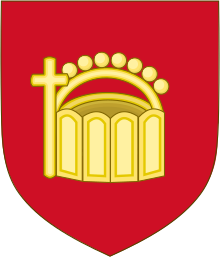

An Arch-Treasurer (German: Erzschatzmeister, Latin: Archithesaurarius) is a chief treasurer, specifically the great treasurer of the Holy Roman Empire. The title of Arch-Treasurer was only ceremonially significant, as it was only used in the coronation of Emperors.[1]
YouTube Encyclopedic
-
1/3Views:4 373 1811 628 8771 024
-
The Untouchables 1987 Extract The Team
-
Demonology Explained in Obsessive Detail
-
Supravalvar Aortic Stenosis, Aortic Arch Abnormalities, and Coarctation (THOMAS E. MACGILLIVRAY, MD)
Transcription
History
During the 30 Years' War, Frederick V, Elector Palatine, lost his electorate and title of Arch-Steward in February 1623 to Maximilian I, Elector of Bavaria. The electorate and Arch-Stewardship was given to Bavaria by the emperor Ferdinand II. After the war, a new electoral position was given to Frederick's son, Charles, and the office of Arch-Treasurer was created for him in 1652.[2]
In 1706, the Bavarian elector was banned, so the palatine elector returned to the office of Arch-Steward while the office of Arch-Treasurer was transferred to the Elector of Hanover in 1710. The Bavarian elector was reinstated in 1714, so the Bavarian, Palatine and Hanoverian electors' offices changed to Arch-Steward, Arch-Treasurer and Arch-Bannerbearer, respectively, but the House of Hanover kept using the shield of the Arch-treasurership anyway (see Royal coat of arms of Great Britain).
The Hanoverian elector returned to the Arch-Treasurer office in 1777, when the Palatine branch of the House of Wittelsbach inherited Bavaria and the Arch-Steward office. They retained their offices until the end of the empire in 1806.
References
- ^ Whaley, Joachim (2011). Germany and the Holy Roman Empire. Oxford: Oxford University Press. p. 75. ISBN 9780199693078.
- ^ "The Holy Roman Empire: Household". www.heraldica.org. Retrieved 2024-05-25.https://www.heraldica.org/topics/national/hre.htm#Household
 This article incorporates text from a publication now in the public domain: Chambers, Ephraim, ed. (1728). Cyclopædia, or an Universal Dictionary of Arts and Sciences (1st ed.). James and John Knapton, et al.
This article incorporates text from a publication now in the public domain: Chambers, Ephraim, ed. (1728). Cyclopædia, or an Universal Dictionary of Arts and Sciences (1st ed.). James and John Knapton, et al. {{cite encyclopedia}}: Missing or empty|title=(help) [1]
